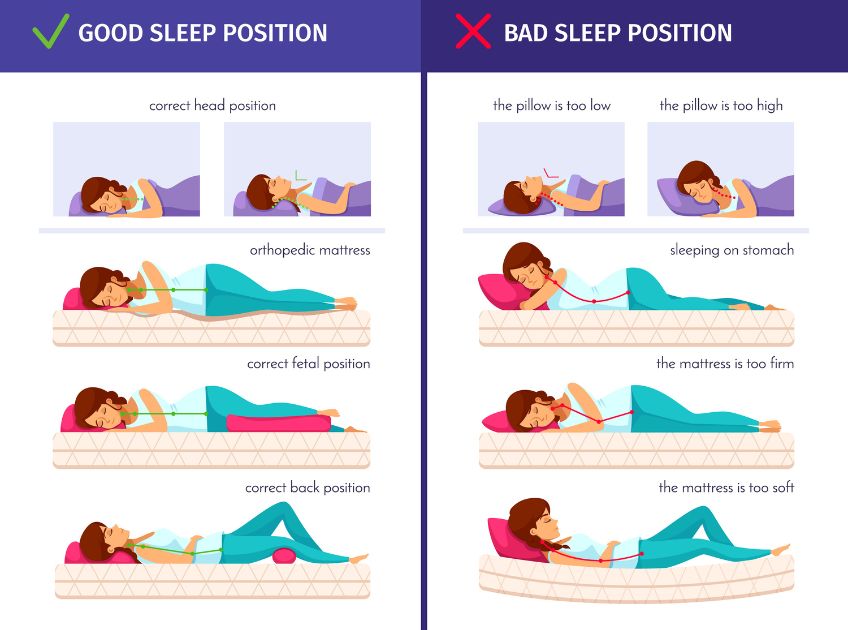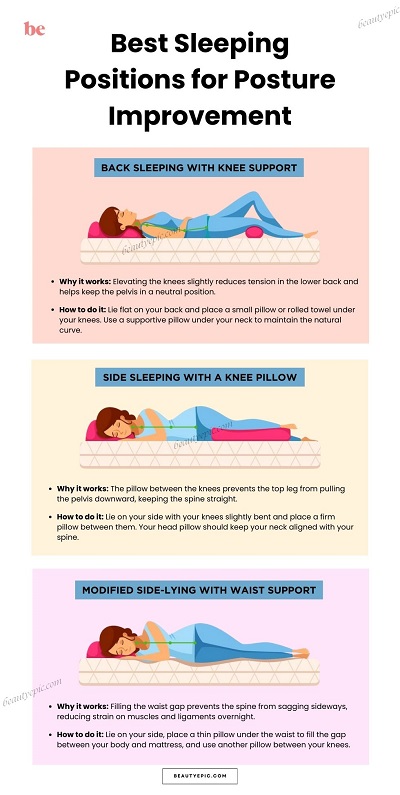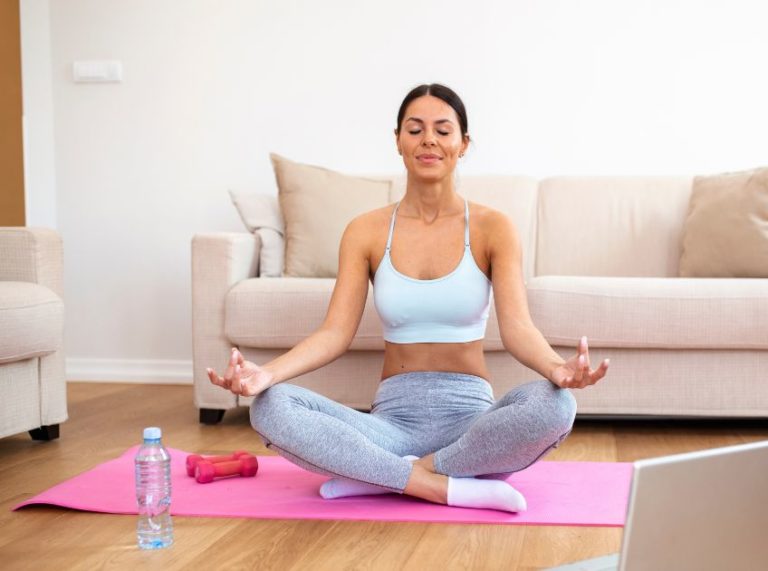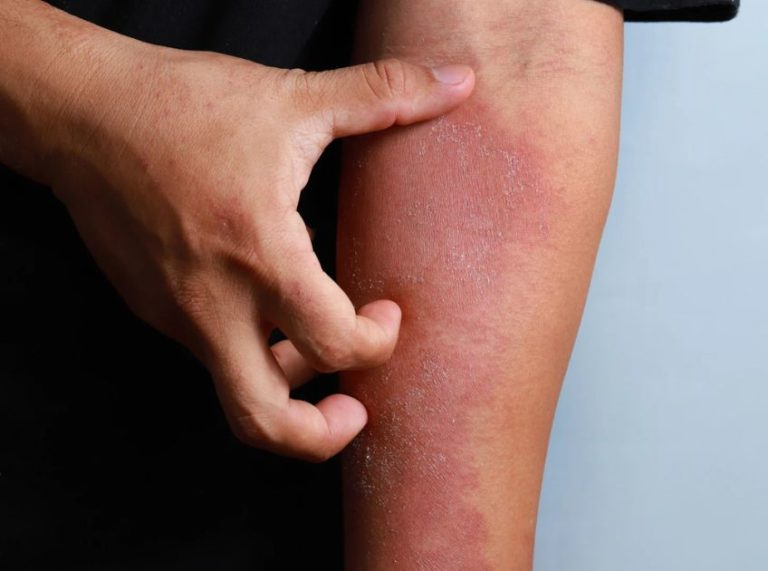
Important: This article is for informational purposes only. Please read our full disclaimer for more details.
Poor posture isn’t just about how you sit or stand; it also develops while you sleep. The wrong sleeping position can strain your spine, shoulders, and hips, exacerbating poor posture over time. Choosing the right position at night helps your muscles relax and supports proper spinal alignment, which can improve posture naturally.
What Does “Sleeping for Better Posture” Mean?
Sleeping for better posture refers to positioning your body so that your spine maintains a neutral curve while you rest. This means avoiding excessive bending or twisting of the neck, shoulders, and lower back. Correct sleeping positions reduce pressure on muscles and ligaments, helping them recover from daytime stress and improving alignment.
Best Sleeping Positions to Support Proper Posture
The way you position your body at night can either help correct bad posture or make it worse. Proper sleeping positions maintain the spine’s natural “S” curve, reduce tension in supporting muscles, and allow your body to heal from daily stress. Here are the most effective positions:
1. Back Sleeping with Knee Support
Lying on your back is one of the best positions for maintaining spinal alignment. It evenly distributes body weight and keeps pressure off the spine.
- How to do it: Lie flat on your back and place a small pillow or rolled towel under your knees. Use a supportive pillow under your neck to maintain the natural curve.
- Why it works: Elevating the knees slightly reduces tension in the lower back and helps keep the pelvis in a neutral position.
- Extra tip: If you experience lower back discomfort, placing a small rolled towel under your lower back can offer added support.
2. Side Sleeping with a Knee Pillow
For many people, side sleeping feels natural and comfortable, but without support, it can tilt the hips and misalign the spine. Adding a pillow between the knees fixes this issue.
- How to do it: Lie on your side with your knees slightly bent and place a firm pillow between them. Your head pillow should keep your neck aligned with your spine.
- Why it works: The pillow between the knees prevents the top leg from pulling the pelvis downward, keeping the spine straight.
- Extra tip: Alternate sides during the night to prevent uneven strain on one side of the body.
3. Reclined or Semi-Fowler’s Position
A slightly reclined sleeping posture, similar to what you achieve with an adjustable bed or wedge pillow, can relieve pressure on the lower spine.
- How to do it: Elevate your upper body at a 30–45-degree angle using a wedge pillow or adjustable mattress. Keep your knees slightly bent with a pillow underneath for extra support.
- Why it works: This position reduces compression in the lumbar area and promotes better spinal alignment, especially helpful for people with lower back pain.
- Extra tip: Pair this with a supportive mattress to avoid sinking into awkward angles.
4. Modified Side-Lying with Waist Support
For those with a pronounced waist or hip curve, placing a small pillow or towel under the waist helps keep the spine neutral.
- How to do it: Lie on your side, place a thin pillow under the waist to fill the gap between your body and mattress, and use another pillow between your knees.
- Why it works: Filling the waist gap prevents the spine from sagging sideways, reducing strain on muscles and ligaments overnight.
- Scientific evidence: A study in Applied Ergonomics showed that sleeping positions that maintain spinal neutrality significantly reduce musculoskeletal discomfort and help correct posture over time (1)(2).
Proper support of the lumbar spine and pelvis was especially linked to improved alignment in people with chronic poor posture.
Sleeping Positions to Avoid for Better Posture
- Stomach Sleeping: This forces your neck to twist and places pressure on your spine, contributing to misalignment.
- Curled-Up Fetal Position: Extreme curling can compress the spine and tighten muscles, leading to stiffness in the morning.
- Unsupported Side Sleeping: Without a pillow between your knees, your hips can tilt, misaligning the spine.
Expert Note: Long-term stomach sleeping has been linked to increased neck and lower back pain due to unnatural spinal rotation, according to research in the Journal of Physical Therapy Science (3).
Frequently Asked Questions (FAQ’S)
1. Can changing my sleeping position fix bad posture?
A. It can’t fix it overnight, but supportive positions help reduce strain and allow muscles to recover, which improves posture over time.
2. What type of mattress is best for posture correction?
A. A medium-firm mattress that supports the spine’s natural curve is ideal for promoting proper alignment during sleep.
3. Should I use multiple pillows for better posture?
A. One supportive pillow under the neck and, if needed, an additional one between the knees or under the back can help maintain alignment without adding strain.
Your sleeping position plays a major role in either correcting or worsening bad posture. By aligning your spine and supporting your body with the right pillows and mattress, you can relieve pressure and help your muscles recover at night. Small adjustments in how you sleep can lead to noticeable improvements in posture and overall comfort during the day.
















